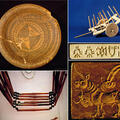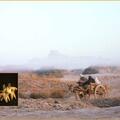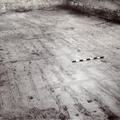The prominent Indian archaeologist Vasant Shinde, in a brand new article Current Perspectives on the Harappan Civilization in A Companion to South Asia in the Past (2016) writes: "The Harappan civilization was first discovered at the site of Harappa in 1924,
344 posts, also carried on our Facebook page, about the ancient Indus Valley civilization, including important news, research and occasional visits to museums with ancient Indus artifacts.
May 19, 2016
The Lahore Museum, whose founding director was Rudyard Kipling, has an important collection of Indus objects and objects from Mehrgarh, some of which are on display in the gallery's display cases.
May 15, 2016
Excavator Ernest Mackay wrote of this well-head in Mohenjo-daro: "Brick lined wells are a common feature, most of the larger buildings and houses having their own, to which the poorer people frequently had access.
May 15, 2016
One the one hand, the priest-king of Mohenjo-daro may look like a real person; on the other, his garment and other signs led the archeologist Ernest Mackay to write, "the only stone image yet discovered which can definitely be said to be that of a deity is a
May 15, 2016
Seals as urban passports? Mackay wrote "most of the inhabitants of the Indus valley seem to have worn amulets of some kind or another. The so-called seal (Pl.
May 4, 2016
"The cylinder seals of Mesopotamia constitute her most original art," wrote the scholar Henri Frankfort, and much the same has been said about the very different square stamp seals used by the ancient Indus civilization.
May 2, 2016
"The favorite toy seems to have been a little pottery cart, to judge from the number of specimens, usually in a damaged condition, which have been found. These miniature carts are practically . . .."
Apr 30, 2016
"The economy of these people must have relied largely on agriculture. Although no cereals were found in the course of excavating the discovery of a ploughed field [1], situated to the south-east of the settlement outside the town-hall, is highly significant."
Apr 30, 2016
John Marshall could hardly believe his eyes when this red jasper statuette was found by M.S. Vats at Harappa: ". . . it seemed so completely to upset all established ideas about early art. Modelling such as this was unknown to the ancient world up to the Hellenistic age of Greece, and I thought, therefore, that some mistake must surely have been made."
Apr 24, 2016
"For the astounding remains of Mohenjo Daro, discovered in 1922 and excavated during the following years, are for the most part in a state of utter disintegration and decay and are rapidly approaching the point of total destruction."
Apr 15, 2016
Exciting news the same week of ancient Indus finds in Botad village in Sarashtra 50 miles from Lothal, including beads and the evidence of industry. And at the giant site of Rakigarhi in Hisar, 15 more skeletons were found in Mound 7. Last year was exciting for its find of 5 skeletons, all of which together should enable DNA and other analysis.
Apr 14, 2016
"The humped bull (Bos indicus) has a long and special association with India. Its association with Siva, its all pervading holiness and its basic usefulness in agriculture and commerce for than four millennia are too well known to need description. Its peculiar importance extends back to prehistoric times."
Apr 12, 2016
However incredible this may seem, there now seems to be good genetic and material evidence that sailors from India arrived in Australia from either Sindh or South India at the height of the ancient Indus civilization.
Apr 10, 2016
"Thus the main motifs of the seal tablets emphasize two cultural phenomena. The first is that there was a rich mythopetic basis for the use of these motifs. The second is that the main motifs emphasize pan-settlement relationships, i.e.
Apr 8, 2016
"Bone and ivory counters with circles and lines, carved in ways that do not correspond to dice, may have been used for predicting the future," writes Mark Kenoyer about these objects in Ancient Cities of the Indus Valley Civilization (p.















